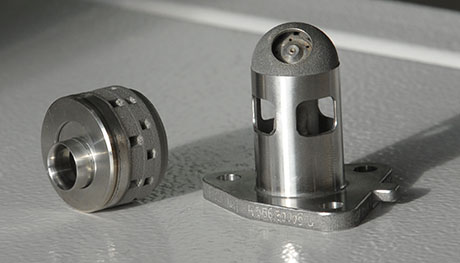Safran Turbomeca Invests in AM for Helicopter Engines

Turbomeca’s new fuel-injector nozzles will be 3D printed, saving both time and costs. Courtesy of Safran.
Latest News
January 19, 2015
Additive manufacturing (AM) has had a major impact in a number of industries. In aerospace, the main draws of the technology are its flexibility, speed and material conservation. Parts that previously would have required months and multiple stages to produce can now be constructed over the course of a single build session.
A number of different airplane manufacturers have invested in AM, and now French helicopter manufacturer Safran Turbomeca will be joining their ranks. The company is in the process of setting up brand new 3D printing facilities at its manufacturing center in Bordes.
 Turbomeca’s new fuel-injector nozzles will be 3D printed, saving both time and costs. Courtesy of Safran.
Turbomeca’s new fuel-injector nozzles will be 3D printed, saving both time and costs. Courtesy of Safran.From the press release:
Arrano test and production engines will feature fuel injector nozzles made using selective laser melting (SLM) techniques. This leading-edge manufacturing process will also be used to manufacture Ardiden 3 combustor swirlers. These engines are Turbomeca’s latest models and amongst the most advanced turboshafts ever designed.
Turbomeca chose AM to leverage its capacity for reducing overall part weight and complexity. Rather than producing a fuel-injector nozzle that is potentially comprised of dozens of parts, the company is capable of 3D printing the fuel-injector nozzle in one build. If that particular idea seems familiar, it may be because we reported on GE Aviation doing it last year.
Along with parts production, buying into new advanced manufacturing methods such as AM is part of Turbomeca’s “Future Line” program, which is intended to modernize its manufacturing capabilities. The company will also be introducing HVOF (High Velocity Oxy-Fuel) coatings, a process meant to improve its compressor and turbine blade manufacturing capabilities at Bordes.
Along with the aforementioned GE Aviation, Turbomeca will be joining companies the likes of Rolls Royce and Lockheed Martin that have already invested in AM. Nearly universally, these companies have reported on savings in both material costs and time to market, thanks to AM.
Below you’ll find a short video about one of Turbomeca’s newest helicopter engines, the Ardiden 3, in which you’ll shortly find 3D printed parts.
Source: Safran
Subscribe to our FREE magazine, FREE email newsletters or both!
Latest News
About the Author
John NewmanJohn Newman is a Digital Engineering contributor who focuses on 3D printing. Contact him via [email protected] and read his posts on Rapid Ready Technology.
Follow DE





